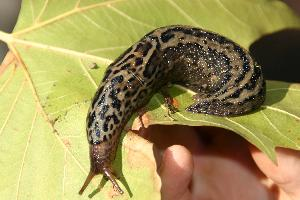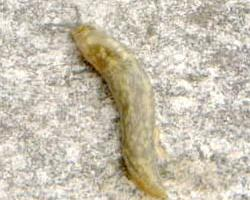
Description de l'animal
The Great grey slug, scientifically known as Limax maximus, is a fascinating creature that inhabits various regions across the globe, particularly thriving in Europe and parts of North America. This species is among the largest of terrestrial slugs, a fact that contributes to its other common name, the leopard slug, due to its distinctive spotted appearance. The body of Limax maximus is elongated and robust, capable of stretching considerably when in motion. On average, an adult can reach up to 20 centimeters (about 8 inches) in length when fully extended, although sizes can vary.The coloration of the Great grey slug is primarily a mottled grey, with patterns that can range from light to dark shades, creating a marbled or leopard-like effect. This coloration not only gives the slug its name but also serves as camouflage against the damp, dark habitats it prefers, such as gardens, woodlands, and other areas rich in moisture and organic material.
One of the most remarkable aspects of Limax maximus is its mating behavior, which is quite unique and complex. These slugs are known for their dramatic and elaborate nocturnal mating rituals, which involve two slugs circling each other, climbing a tree or another vertical structure, and then dangling from a mucus thread they produce. While suspended, they exchange spermatozoa in a visually striking display that can last for several hours. This process is not only a fascinating spectacle but also an essential part of their reproductive cycle.
As detritivores, Great grey slugs play a crucial role in their ecosystems. They feed on a variety of materials, including dead plant matter, fungi, and even other slugs, helping to break down and recycle nutrients back into the soil. Despite their beneficial role, they are often considered pests in gardens and agricultural settings, where they can cause significant damage to crops and ornamental plants.
Great grey slugs have a few natural predators, including birds, toads, snakes, and some insect species, which help to keep their populations in check. However, their ability to produce a thick layer of mucus makes them less palatable to many potential predators. This mucus is also crucial for their mobility, allowing them to glide smoothly over rough surfaces, and serves as a protective barrier against dehydration and predators.
Adaptable and resilient, Limax maximus has successfully colonized many parts of the world beyond its native range, often transported inadvertently through the horticultural trade. This adaptability, combined with their reproductive strategy and dietary habits, ensures their survival in a wide range of environments, making the Great grey slug a creature of both ecological significance and general intrigue.
Animaux similaires
Nouvelles photos d'animaux
Top 10 des animaux
- Dolphin gull (Leucophaeus scoresbii)
- Diana monkey (Cercopithecus diana)
- Moustached guenon (Cercopithecus cephus)
- Galápagos tortoise (Geochelone nigra complex)
- Russian tortoise (Testudo horsfieldii)
- Stone loach (Barbatula barbatula)
- Japanese macaque (Macaca fuscata)
- Greek tortoise (Testudo graeca)
- Common flying dragon (Draco volans)
- Vendace (Coregonus albula)

